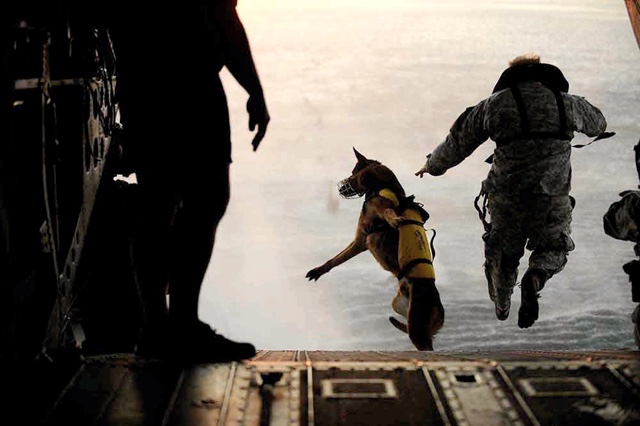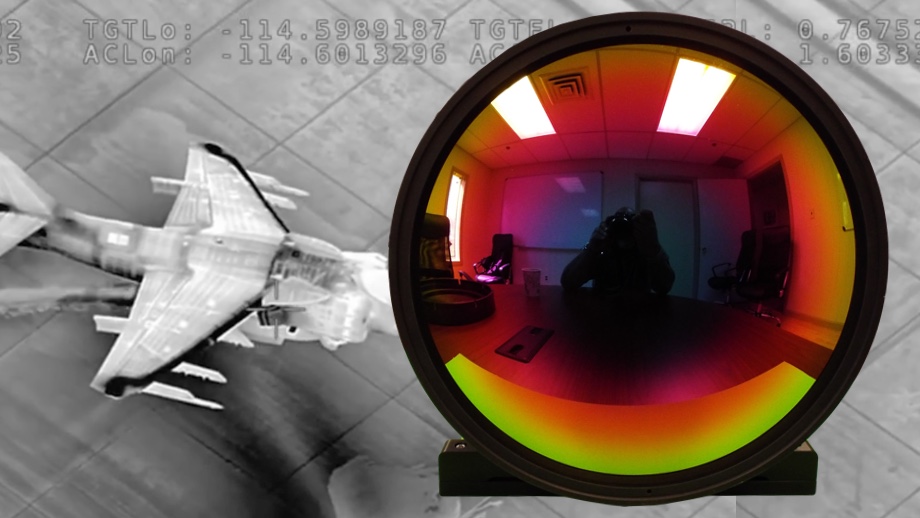

LWIR uncooled and Mwir cooled zoom thermal imaging Flir ir germanium optical lenses by SPI
Long range LWIR MWIR SWIR long range precision optical lens catalog
LENS OPTIONS:
15-225 mm MWIR continuous zoom hardened, coated/sealed germanium lens.
18-335 mm MWIR continuous zoom hardened, coated/sealed germanium lens.
35-670 mm MWIR continuous zoom hardened, coated/sealed germanium lens.
35-720 mm MWIR continuous zoom hardened, coated/sealed germanium lens.
35-835 mm MWIR continuous zoom hardened, coated/sealed germanium lens.
88-1420 mm MWIR continuous zoom hardened, coated/sealed germanium lens.
15-305 mm MWIR continuous zoom hardened, coated/sealed germanium lens.
47-595 mm MWIR continuous zoom hardened, coated/sealed germanium lens.
88-1220 mm MWIR continuous zoom hardened, coated/sealed germanium lens.
55-1650 mm MWIR continuous zoom hardened, coated/sealed germanium lens.
 Cooled thermal camera lenses are needed for a thermal sensor to fullfill its ultimate purpose. Highly sensitive InSb and MCT sensors are only half of the equation. To truly leverage the power of cooled thermal sensors, you need a good lens. So, what makes a good lens? Like everything of quality in life there is no one data marker that you can point to and say; “oh well if it has that then it must be the best”. Rather, it is a combination of factors that determine a lenses quality. The main specifications of a thermal lens include: the lenses focal length, f/#, coating, alignment with the thermal sensor, size of the thermal sensor, pixel pitch of the thermal sensor, athermalization of the lens and environmental housing. That is a lot of factors. I am sure that you can now see that the question is not “what is the best cooled thermal lens” but “what is the RIGHT thermal lens for my needs”? So, with all these specifications to juggle how do I know what is the right thermal lens to choose? Lets start by looking at some of these options and figuring out what they mean.
Cooled thermal camera lenses are needed for a thermal sensor to fullfill its ultimate purpose. Highly sensitive InSb and MCT sensors are only half of the equation. To truly leverage the power of cooled thermal sensors, you need a good lens. So, what makes a good lens? Like everything of quality in life there is no one data marker that you can point to and say; “oh well if it has that then it must be the best”. Rather, it is a combination of factors that determine a lenses quality. The main specifications of a thermal lens include: the lenses focal length, f/#, coating, alignment with the thermal sensor, size of the thermal sensor, pixel pitch of the thermal sensor, athermalization of the lens and environmental housing. That is a lot of factors. I am sure that you can now see that the question is not “what is the best cooled thermal lens” but “what is the RIGHT thermal lens for my needs”? So, with all these specifications to juggle how do I know what is the right thermal lens to choose? Lets start by looking at some of these options and figuring out what they mean.
FOCAL LENGTH- When discussing long range cooled thermal camera lenses, this is going to be the first specification you come across. Quite simply the focal length is the distance from the front of the optic to the point at the back where it focuses the energy that you are imaging. In the world of long range thermal imaging it is generally assumed that a longer focal length is used to see farther distances. A longer focal length will also result in a narrower field of view. So, with long lenses you can see farther away but you see a narrower area. For example (numbers made up for ease of calculation) if a 100mm lens could see a person at 1,000 meters and had a horizontal field of view of 15 degrees, then a 1500mm lens could see a person at 15,000 meter but would have a narrow horizontal field of view of only 1 degree. This makes it easy to see far but difficult to track targets closely. That is where the cooled thermal camera ZOOM lens comes in to play. For long range thermal surveillance, the right lens in this example would be a 100mm-1500mm continuous zoom optic. This type of cooled thermal camera zoom lens provides a 100mm FOV, a 1500mm FOV and every FOV in between. The thermal zoom lens makes it easy to select the perfect FOV for the target you need to track.
Long range LWIR MWIR SWIR long range precision optical lens catalog
Call Mike at 702-499-9551 for Low Priced Cooled MWIR Thermal Lenses or Complete MWIR Cooled thermal FLIR IR Cameras systems or email [email protected]
The question is not “what is the best cooled thermal lens” but “what is the RIGHT thermal lens for my needs”The Lens Guy
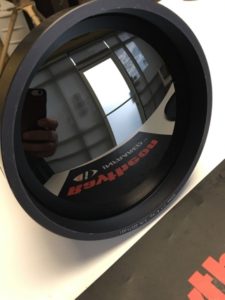 THE F/#- The f/# of a lens indicates the size of the opening in the front of the lens in relation to its focal length. The f/# is the ratio of that comparison. The lower the f number (known as a “fast” lens) the more energy it lens will focus onto the sensor. For example an f/1 lens indicates that the opening aperture of the lens is equal (1:1) with the focal length of the lens. So, if you have a 1500mm focal length lens @ f/1 then the opening would be a whopping 1500m diameter! This is one of the main reasons that long range thermal imaging is difficult for uncooled thermal sensors. The reduced sensitivity of uncooled sensors requires ultra fast f/1 optics. Conversely, a cooled thermal camera is 4 times more sensitive so it can be used with thermal lenses that are f/4-f/5.5. This gives you a lens that is much more manageable in the ultra long range. That same 1500mm lens at f/5.5 would only have an entrance diameter of 273mm. Clearly much smaller and more manageable. Fortunately, this is not a big concern when looking at long range cooled thermal cameras as this number is dictated by the system design and we should look to other factors to find the “right” lens.
THE F/#- The f/# of a lens indicates the size of the opening in the front of the lens in relation to its focal length. The f/# is the ratio of that comparison. The lower the f number (known as a “fast” lens) the more energy it lens will focus onto the sensor. For example an f/1 lens indicates that the opening aperture of the lens is equal (1:1) with the focal length of the lens. So, if you have a 1500mm focal length lens @ f/1 then the opening would be a whopping 1500m diameter! This is one of the main reasons that long range thermal imaging is difficult for uncooled thermal sensors. The reduced sensitivity of uncooled sensors requires ultra fast f/1 optics. Conversely, a cooled thermal camera is 4 times more sensitive so it can be used with thermal lenses that are f/4-f/5.5. This gives you a lens that is much more manageable in the ultra long range. That same 1500mm lens at f/5.5 would only have an entrance diameter of 273mm. Clearly much smaller and more manageable. Fortunately, this is not a big concern when looking at long range cooled thermal cameras as this number is dictated by the system design and we should look to other factors to find the “right” lens.
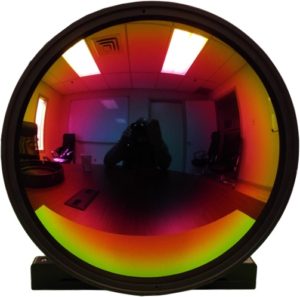 COATING- All cooled thermal camera lenses are coated in order to perform properly and reduce unwanted stray energy. The basic anti-reflective coating is standard on all thermal lenses and is designed to eliminate that stray energy. Better lenses have whats called a DLC or HDLC coating. The Hard Diamond Like Coating of these lenses protects them from atmospheric pitting and blowing dust. In long range thermal imaging this matters. The size of these lenses usually means that the lens front element is exposed to the environment in the housing. The shear size of the lens prevents the use of IR transparent windows since they need to be so large and thick to cover the objective lens diameter. The quality of the coating is the most important thing to keep in mind. They will all be A/R and DLC and they will work great when new. But, if the coating is not applied correctly then it will quickly deteriorate leaving you with a garbage image. So, how can you be sure you are getting quality? It is a challenge. But, there is a way. Start by buying from an experienced supplier, such as SPI Corp. Next (this is critical) demand a domestic USA company to supply your lens and system. Why is this important? There are very strict guidelines regarding export/import of cooled thermal camera technology. US manufacturers must comply with these laws and use the best domestic product. Foreign suppliers (North American like Canada or Mexico, European and Asian) do not have to comply and in fact are incentivized to use foreign low cost parts. The use of Chinese lenses allows them to export all over the world. Needless to say, Chinese lenses are the “good cooled thermal camera lenses”.
COATING- All cooled thermal camera lenses are coated in order to perform properly and reduce unwanted stray energy. The basic anti-reflective coating is standard on all thermal lenses and is designed to eliminate that stray energy. Better lenses have whats called a DLC or HDLC coating. The Hard Diamond Like Coating of these lenses protects them from atmospheric pitting and blowing dust. In long range thermal imaging this matters. The size of these lenses usually means that the lens front element is exposed to the environment in the housing. The shear size of the lens prevents the use of IR transparent windows since they need to be so large and thick to cover the objective lens diameter. The quality of the coating is the most important thing to keep in mind. They will all be A/R and DLC and they will work great when new. But, if the coating is not applied correctly then it will quickly deteriorate leaving you with a garbage image. So, how can you be sure you are getting quality? It is a challenge. But, there is a way. Start by buying from an experienced supplier, such as SPI Corp. Next (this is critical) demand a domestic USA company to supply your lens and system. Why is this important? There are very strict guidelines regarding export/import of cooled thermal camera technology. US manufacturers must comply with these laws and use the best domestic product. Foreign suppliers (North American like Canada or Mexico, European and Asian) do not have to comply and in fact are incentivized to use foreign low cost parts. The use of Chinese lenses allows them to export all over the world. Needless to say, Chinese lenses are the “good cooled thermal camera lenses”.
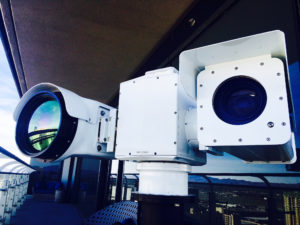
SPI LONG RANGE M9 PTZ FLIR THERMAL ZOOM EOIR SECURITY CAMERA SYSTEM
THE REST OF THE PICTURE- Lens alignment, sensor size, pixel pitch and more all contribute to the quality of the final cooled thermal camera. The most critical of this spec group is the sensor size and (to a lesser degree) the pixel pitch. The sensor size is the number of pixels in the Focal Plane Array. Typical cooled thermal camera sensors have resolutions of 640×512 and can go as high as 4K plus for exotic space borne imaging sensors. The pixel pitch is the size of each pixel in that array. Not a very sexy specification but it does have a direct relationship to FOV for a given focal length. These are hard specs to nail down and some (like alignment) do not even have a numerical specification to publish. What do you do? The best course of action is to find a reputable supplier (SPI CORP) and speak with a knowledgable application engineer. Explain what you want the cooled thermal camera lens to accomplish. Speak in terms of your mission not specifications. You want to ask for a system that can see large vessels at 50km and people in the water at 5km rather than ask for a 1200mm lens. Someone with experience can easily guide you through the myriad of choices, point out a reasonable solution AND tell you WHY it is the best solution. Like everything else in life, do your homework but concentrate on what you want to accomplish not on arbitrary data points. If you follow this mantra then you will truly find the RIGHT COOLED THERMAL CAMERA LENSES FOR YOU.
COOLED THERMAL CAMERA LENSES
To continue your research into cooled thermal cameras and lenses check out some of the systems below. Call us anytime to discuss your unique needs. WE LIVE TO SERVE.




